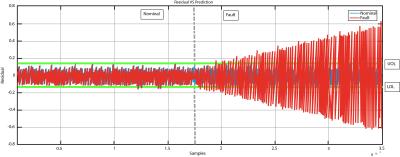
Compatible with all of NUM’s latest-generation Flexium+ CNC systems, the NUMai software package is a complete, fully integrated solution for CNC machine tools – it does not require any additional sensors, and runs on the same industrial PC as the CNC system’s HMI (human-machine interface).
NUMai software can be utilized as soon as a machine tool has been commissioned and is ready to start production, or on a machine that is already being employed for production purposes. The software initially acquires all pertinent operating data over a period of time, typically a number of hours, while the machine is being used for normal production tasks. Ideally, a diversity of part programs is run, involving a variety of different machining conditions, in order to ensure that the data is as comprehensive and reliable as possible.
The collected data is used to teach a neural network so that any deviation from the ‘good’ machine behavior and performance can then be detected and predicted; a suitable PC program for subsequent online performance monitoring and diagnostic purposes is generated automatically.
During the software’s development, NUM beta tested the technology on a CNC milling machine equipped with three axes and a spindle, which required a neural network comprising 36 neurons with three hidden layers. In this particular instance, 396 parameters needed their values to be accurately defined; this required the acquisition of more than 2 million ‘known good’ data points and 300 iterations of the teaching phase, which took about four hours per axis.
NUMai condition monitoring software capitalizes on the inherent flexibility of NUM’s latest-generation Flexium+ CNC platform. As standard, every Flexium+ CNC system includes a PC which can handle data from the servo drives’ measurement points, a PLC that has direct access to machine parameters, and an NCK oscilloscope feature capable of reading values in real-time. All system communications are handled by FXServer, using fast real-time Ethernet (RTE) networking.
During everyday use in the production environment, NUMai software runs in the background on the industrial PC that forms part of the machine tool’s CNC system, continuously monitoring and evaluating the machine’s performance. Any discrepancy or deviation beyond user-defined thresholds is notified to the PLC, which decides what action should be taken – from a simple advisory message to an emergency disengagement.
The new NUMai condition monitoring software option can be installed and used on any Flexium+ CNC system running NUM’s Flexium software version 4.1.10.10 or higher.
Contact Details
Related Glossary Terms
- computer numerical control ( CNC)
computer numerical control ( CNC)
Microprocessor-based controller dedicated to a machine tool that permits the creation or modification of parts. Programmed numerical control activates the machine’s servos and spindle drives and controls the various machining operations. See DNC, direct numerical control; NC, numerical control.
- gang cutting ( milling)
gang cutting ( milling)
Machining with several cutters mounted on a single arbor, generally for simultaneous cutting.
- milling
milling
Machining operation in which metal or other material is removed by applying power to a rotating cutter. In vertical milling, the cutting tool is mounted vertically on the spindle. In horizontal milling, the cutting tool is mounted horizontally, either directly on the spindle or on an arbor. Horizontal milling is further broken down into conventional milling, where the cutter rotates opposite the direction of feed, or “up” into the workpiece; and climb milling, where the cutter rotates in the direction of feed, or “down” into the workpiece. Milling operations include plane or surface milling, endmilling, facemilling, angle milling, form milling and profiling.
- milling machine ( mill)
milling machine ( mill)
Runs endmills and arbor-mounted milling cutters. Features include a head with a spindle that drives the cutters; a column, knee and table that provide motion in the three Cartesian axes; and a base that supports the components and houses the cutting-fluid pump and reservoir. The work is mounted on the table and fed into the rotating cutter or endmill to accomplish the milling steps; vertical milling machines also feed endmills into the work by means of a spindle-mounted quill. Models range from small manual machines to big bed-type and duplex mills. All take one of three basic forms: vertical, horizontal or convertible horizontal/vertical. Vertical machines may be knee-type (the table is mounted on a knee that can be elevated) or bed-type (the table is securely supported and only moves horizontally). In general, horizontal machines are bigger and more powerful, while vertical machines are lighter but more versatile and easier to set up and operate.

